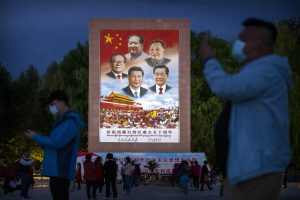The transformation of the People’s Republic of China (PRC) over the past 75 years from an impoverished, war-torn nation to a global power is an impressive story of both modern state-building and the creation of a new center of power in the international system. At home, the Chinese Communist Party (CCP) has ruled without significant opposition since the country’s inception, hundreds of millions of Chinese have moved out of poverty, and the economy has grown on average 9 percent per year for over four decades. Internationally, the PRC has become the world’s largest trading power, boasts the world’s largest military, and is a leading innovator in critical technologies such as electric vehicles, 5G, and artificial intelligence.
For China’s preeminent leader, Xi Jinping, these achievements are important signposts on the road to realizing his vision of the great rejuvenation of the Chinese nation. Since he assumed the position of CCP general secretary in November 2012, Xi has unleashed a torrent of bold-faced initiatives – such as the Belt and Road, Made in China 2025, and “common prosperity” – that are designed to shape a new China. In Xi’s vision, this rejuvenated China will reflect a robust CCP at the forefront of the political system, a powerful and innovative economy that rivals that of the United States and other advanced industrialized nations, a military that is capable of “fighting and winning wars,” and a nation that has realized its sovereignty ambitions and reclaimed its centrality on the global stage.
Xi is not the first PRC leader to articulate a vision of a rejuvenated China. Every leader since the founding of the country has put forth a strategy or set of policies to realize China’s restoration and rejuvenation.
On the surface, there is little that connects Xi Jinping’s PRC to that of Mao Zedong and Deng Xiaoping. But a closer examination of Xi’s rejuvenation strategy reveals that contemporary China is not only rooted in an enduring set of political and economic principles and institutions established at the inception of the country – the primacy of a highly centralized system of single party rule; extensive CCP control over political and social life, including the judicial system, media, and education; and an economy that reflects a mix of both market-based practices as well as the strong hand of the state in core sectors such as telecommunications and energy – but also reflects a high degree of policy continuity.

































